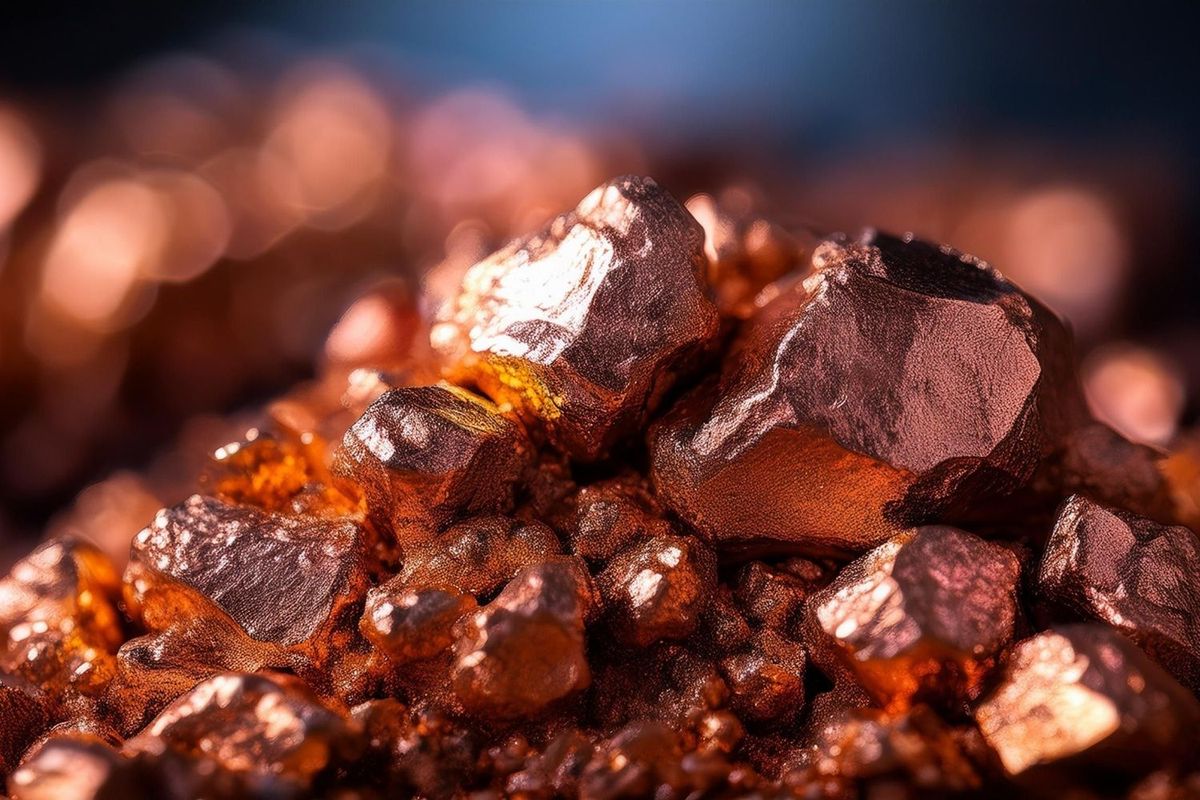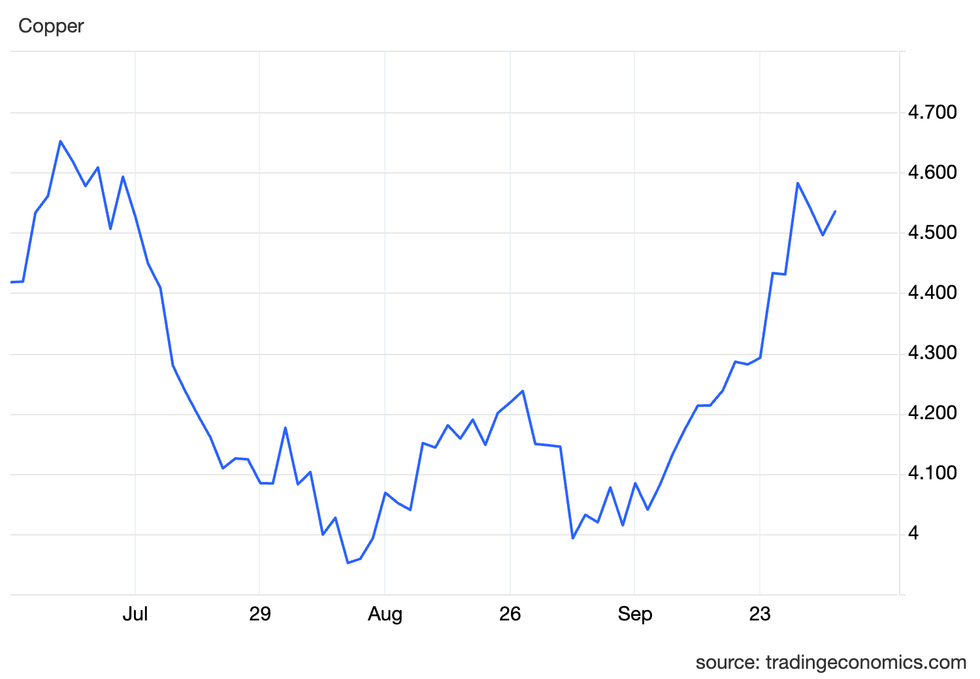Copper Price Update: Q3 2024 in Review
The copper price pulled back in the third quarter after H1's record-setting advances. Learn what supply and demand factors were at play during the period.

Copper set record high prices during the first half of 2024, reaching US$5.11 per pound on May 21. Although the price pulled back during the third quarter, it has largely remained elevated compared to the past two years.
Prices since the start of the year have been affected by several factors, including increased demand from sectors tied to the energy transition and the push to reduce carbon footprints. Rising demand comes while the Chinese real estate sector – traditionally a top global consumer of refined copper – remains stalled.
Despite increasing demand, copper has remained in a surplus position with the International Copper Study Group (ICSG), an autonomous United Nations inter-governmental body, estimating a balance of 535,000 metric tons (MT) through the first eight months of the year.
What happened to the copper price in Q3?
At the start of the quarter, copper was priced at US$4.42 per pound before reaching a quarterly high of US$4.65 on July 5. However, the momentum was short-lived and, by the middle of July, the red metal had resumed a downward trend.
The price continued to slump until reaching a quarterly low of US$3.95 per pound on August 7. The rest of the month saw copper trading closer to quarterly lows, rising slightly to US$4.23 by August 27, but regressing below the US$4 mark to the start of September.

Copper price chart, July 1 to September 30, 2024.
Chart via Trading Economics.
The lower pricing may have been due to market participants remaining on the sidelines following solid gains in Q2. Fastmarkets analysis noted that copper supply and demand fundamentals were not causing record high prices but rather speculative investment.
However, as the quarter came to a close, the price of copper saw substantial gains as it once again climbed to US$4.50 on September 30.
Primary copper mine supply grows
According to the ICSG report released on October 21, mine production of copper increased by approximately 2 percent to 14.86 million MT in the January to August period versus the 14.56 million MT produced in the same period of 2023.
In particular, Chile had a 3 percent production growth increase from BHP’s (ASX:BHP,NYSE:BHP) Escondida mine and Anglo American (LSE:AAL,OTCQX:AAUKF), Glencore (LSE:GLEN,OTC Pink:GLCNF) and Mitsui (OTC Pink:MITSF,TSE:8031) joint venture Collahausi mine. Additional output came from the ramp-up of Teck’s (TSX:TECK.A,TECK.B,NYSE:TECK) Quebrada Blanca mine expansion at the end of 2023.
Preliminary data suggests an 11 percent uptick from operations in the Democratic Republic of Congo (DRC), as expansions at CMOC’s (OTC Pink:CMCLF,SHA:603993) Kinsanfu and Tenke and Ivanhoe’s (TSX:IVN,OTCQX:IVPAF) and Zijin’s (OTC Pink:ZIJMF,SHA:601899) joint venture Kamoa-Kakula begin to ramp up.
The group also noted a 22 percent increase in output from Indonesia as Freeport McMoRan (NYSE:FCX) and Indonesia Asahan Aluminum’s Grasberg mine and Amman Mineral’s (IDX:AMMN) Batu Hijau mines recovered from operational constraints due to rainfall and landslides in 2023. However, the ICSG indicated a 0.7 percent decline in output from Peru as several mines there saw lower production levels and a 5 percent decline in output from the United States.
Refined copper supply grows, but market still tight
Even though the mining supply has slightly increased over 2023, treatment charges at refiners remain low. FastMarkets reported on October 17 that although discussions were in the early stages, TCs were expected to be agreed in the US$20 to US$30 per MT range, well below the US$80 charged in 2023.
They’ve attributed the low pricing to tightness in the concentrate market and a significantly expanded smelter capacity, particularly in China. They also predict further challenges as more capacity is set to come online in 2025, with projects being completed in Indonesia, China and India.
Overall, these low treatment charges have already sent ripples through the market, and global smelter capacity has been seen to be below normal seasonal levels, with 16.2 percent inactive during the first seven months of the year versus 13.9 percent from the same period in 2023.
While inactivity eased from the 20 percent high in June, it remained elevated, and with continued low treatment charges, further curtailments or outright closures are possible.
Despite the cuts at refiners, the ICSG estimates that refined copper production increased 5 percent during the first eight months of 2024, which included a 5.2 percent increase in primary production and a 4.6 percent increase in recycling copper.
Much of the increase is attributed to a 6.5 percent growth from Chinese sources owing to smelter expansions and a 16 percent increase from DRC following the ramp-up of new facilities there. Output from the two countries represents 54 percent of the global refined copper supply.
Elsewhere, the US saw an 8 percent increase, but was more a result of decreased output in 2023, while Japan saw refined production climb by 3.8 percent. Chilean production decreased by 7 percent, while the EU fell by 2 percent.
Copper demand sees a slight increase
Even though supply saw gains, so did demand, which saw a 2.5 increase through the first part of the year.
A large portion of copper demand was destined for Asian markets, particularly a 2.7 percent growth from China and a 0.5 percent increase in refined copper imports. The rest of the world saw a 2 percent increase, but copper usage growth was constrained by weak demand from the European Union, United States and Japan.
Copper markets have been forecast to see deficits over the next several years as demand is expected to increase over the next few years but still have to materialize. Managing Director of CPM Group Jeffrey Christian made the point in his Copper Market Outlook: Supply Deficits and Demand Fuel Record Prices webinar released on October 18.
“This longer-term expectation that the energy transition will demand tremendous amounts of copper and that there is a lack of new mine supplies available to meet that demand. Both of those are true. Both of them probably are overhyped right now in the market,” he said.
Christian sees potential for new mine supply but suggests the mining industry hasn’t activated yet to start exploiting those resources. He notes challenges to getting production started include government regulations, resource nationalism and a lack of funding for exploration.
Another issue that’s been weighing on copper prices is the weak demand from China owing to a flagging real estate sector there. The government has tried implementing several measures over the past few years to jump-start the sector but has had little impact on the market.
The Chinese government recently instituted new policies in September and October to bolster the housing market. Among the initiatives include support for renovation projects, allowing local governments to issue bonds to acquire commercial properties to convert to affordable housing and requesting banks lower interest rates for mortgages.
While the effects of these measures have yet to work through the system, market watchers expect the Chinese real estate sector to halt its declines in 2025. However, they were cautious in saying it would be a reversal, suggesting prices would see 2 percent growth over the next two years.
China represents more than half of the global demand for the base metal, and its real estate industry makes up 20 to 30 percent of that demand, making the sector an important driver of the price of copper.
“We expect the recently announced government programs to lead to stronger demand for raw materials, including copper, over the next couple of years,” Christian said.
What can copper investors expect in 2024?
Although copper prices surged earlier in the year, they’ve been range bound since the start of the third quarter, sitting at US$4.50 per pound on November 5. Copper prices rely on supply and demand fundamentals due to its practical applications, unlike gold or silver which are valued as safe-haven investments.
The most critical things for investors to look toward are surpluses and deficits in the market. Demand is expected to increase due to the energy transition. New solar, wind, and hydro plants require staggering amounts of copper to generate and transmit power. Electric vehicles and hybrids are also seeing growing consumer demand, but manufacturers are working toward mandated dates to switch production to electric fleets.
Earlier this year, the International Energy Forum released a report that to maintain current increases in demand, 1.1 new mines with an average production of 472,000 MT will have to come online annually until 2050. Adding demand from EVs increases the number of mines to 1.7 per year.
However, a new mine can take over 20 years to move from discovery to production, so even meeting the baseline figure will be challenging for the industry.
This movement into the supply deficit may provide significant opportunities for investors. Companies that already have production will likely see the initial benefit as their margins improve alongside a rising copper price. Companies with mines in development and late-stage exploration projects will follow.
Investors need to stay updated on companies they’re considering investing in. Politics and resource nationalism continue to influence project development and mining operations. Even established companies are not immune, and no investment is guaranteed.
Don’t forget to follow us @INN_Resource for real-time news updates!
Securities Disclosure: I, Dean Belder, hold no direct investment interest in any company mentioned in this article.
- What Factors Affect Copper Supply and Demand? ›
- What Was the Highest Price for Copper? (Updated 2024) ›
- Is Now a Good Time to Invest in Copper? Panelists Tout Long-term Fundamentals ›
- When Will Copper Go Up? ›





